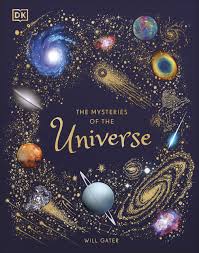Mystery of Universe
The universe encompasses all of space and time, as well as its contents, which include planets, stars, galaxies, and all other forms of matter and energy. The Big Bang Theory is the most widely accepted cosmological explanation for the evolution of the universe. According to this theory's estimates, space and time coexisted 13.7990.021 billion years ago, and the cosmos has been expanding ever since. While the spatial size of the entire universe is unknown, the cosmic inflation equation implies that it must have a minimum diameter of 23 trillion light-years, and the size of the observable universe, which is about 93 billion light-years in diameter at the present time, can be measured. The first cosmological conceptions of the cosmos were geocentric, with Earth at the center, and were created by ancient Greek and Indian thinkers. More precise astronomical measurements throughout the ages prompted Nicolaus Copernicus to establish the heliocentric hypothesis, which places the Sun at the center of the Solar System. Isaac Newton expanded on Copernicus' work, as well as Johannes Kepler's equations of planetary motion and Tycho Brahe's observations, in creating the law of universal gravitation.
Further advances in observational technology revealed that the Sun is one among hundreds of billions of stars in the Milky Way, which is one of a few hundred billion galaxies in the cosmos. Planets can be found around many of the stars in a galaxy. At the greatest scale, galaxies are spread equally and in all directions, implying that the universe lacks both an edge and a core. At lower sizes, galaxies are arranged in clusters and superclusters, which produce enormous filaments and voids in space, resulting in a massive foam-like structure. Discoveries in the early twentieth century showed that the cosmos had a beginning and that space has been expanding at an accelerating rate since then. According to the Big Bang hypothesis, the original density of energy and matter has decreased as the universe has expanded. The cosmos gradually cooled and continued to expand after an initial rapid expansion known as the inflationary period at about 1032 seconds, and the separation of the four known basic forces, permitting the formation of the first subatomic particles and elementary atoms. Under the force of gravity, the dark matter eventually collected, producing a foam-like structure of filaments and gaps. Giant clouds of hydrogen and helium were progressively attracted to the densest areas of dark matter, producing the earliest galaxies, stars, and everything else observed today.
The Big Bang hypothesis is the dominant cosmological model that explains the existence of the observable universe from its inception through its subsequent large-scale development. The model depicts how the universe grew from a high density and temperature starting point, and it provides a complete explanation for a wide variety of observable phenomena, including the abundance of light elements, cosmic microwave background (CMB) radiation, and large-scale structure. The movement of galaxies has revealed that the universe contains far more matter than is accounted for by visible objects like stars, galaxies, nebulae, and interstellar gas. This invisible substance is referred to as dark matter (dark means that there is a wide range of strong indirect evidence that it exists, but we have not yet detected it directly). The CDM model is the most commonly accepted universe model. It implies that about 69.2 percent 1.2 percent [2015] of the mass and energy in the universe is a cosmological constant (or, in extensions to the CDM, other types of dark energy, such as a scalar field) that is responsible for the present expansion of space. Dark matter accounts for approximately 25.8 percent of the total [2015]. As a result, ordinary ('baryonic') matter constitutes just 4.84 percent 0.1 percent [2015] of the physical cosmos. Stars, planets, and visible gas clouds account for just around 6% of ordinary stuff. There are numerous conflicting ideas regarding the eventual fate of the universe and what, if anything, preceded the Big Bang, while some physicists and philosophers refuse to speculate, believing that previous states will never be accessible. Some scientists have proposed different multiverse ideas in which our world may be one of many other universes that also exist.
A galaxy is a massive collection of gas and dust, as well as billions of stars and their solar systems, bound together by gravity. Some are spiral-shaped, like our Milky Way Galaxy, while others are smooth and round. NASA telescopes are assisting us in understanding how galaxies originate and evolve throughout time. If scientists know the cosmos is growing, they should be able to predict how huge it is, right? Unfortunately, scientists are unable to put a monetary value on it. They'd need to know the form of the universe and its pace of expansion, among other things—both of which are mysteries. There are several ideas regarding the form of the cosmos proposed by scientists. However, the dominant hypothesis, according to NASA, is that the cosmos is flat, which leads them to assume that it is limitless in size. However, because the cosmos has a known beginning and maybe an anticipated ending, we can only witness a finite volume of it. "All we can legitimately infer is that the cosmos is far greater than the volume we can directly witness," NASA adds. Since the early 1960s, scientists have hypothesized that sentient life exists outside of Earth. The problem is that there is no scientific proof. So yet, we have no hard scientific proof that any life exists outside of Earth. However, the day may be approaching when science verifies the existence of life outside in our solar system, galaxy, or cosmos.
Interesting facts about our universe/ space-
--With a mass around 330,000 times that of Earth, the Sun accounts for 99.86 percent of the mass in our solar system. Did you know that the Sun is composed primarily of hydrogen (three-quarters of its mass), with helium accounting for the remainder? Would the Sun's voice be loud and squeaky from all that helium?
-- The Sun is big enough that about 1.3 million Earth could fit within (if squished in), or 960,000 Earths could fit if the Earths kept their spherical shape. But can you imagine how many Earths there are?
--There are about three trillion trees on Planet Earth, and between, 100-400 billion stars approximately, in the galaxy.
-- Sunsets on Mars would look bluish to human spectators viewing from the red planet, much as colors are rendered more dramatic in sunsets on Earth. Fine dust increases the visibility of the blue near the Sun's section of the sky, whereas regular daylight increases the visibility of the Red Planet's characteristic rusty dust hue.
-- Venus has a sluggish axis rotation and its day lasts 243 Earth days. Venus's orbit around the Sun is 225 Earth days, therefore a year on Venus is 18 days shorter than a day on Venus.
" The universe is not made of atoms. It's made of tiny stories."
- Joseph Gordon Levitt
Scientists play an important role not only in avoiding inappropriate and dangerous decisions but also in advising policymakers and other stakeholders on the best and wisest steps to take toward a human-centered society, thereby fostering scientific knowledge and enhancing cross-cultural connections and collaborative research. We wouldn't have GPS, reliable weather forecasting, solar cells, or UV filters in sunglasses and cameras if space projects didn't exist. There is also medical research going on in space right now that might heal illnesses and extend human lives, which cannot be done on Earth. We may use space travel to confirm or refute scientific hypotheses created on Earth. Understanding gravity, the magnetosphere, the atmosphere, fluid dynamics, and the geological development of other planets, for example, has come through studying the solar system.
Why can we recognize this individual only by looking at this photo in the blink of an eye? Stephen Hawking is the only person who has done a lot of excellent work and is well-known across the world. Guys, I assure you that this blog will be really useful to some crazed young minds out there! Help individuals with overflowing minds by directing them to this fantastic and educational blog.
French language tour: https://bustlingmindd.blogspot.com/2021/10/french-language-tour.html







